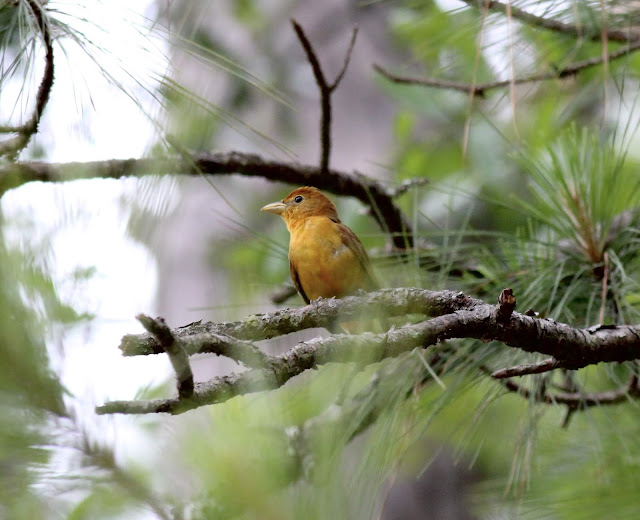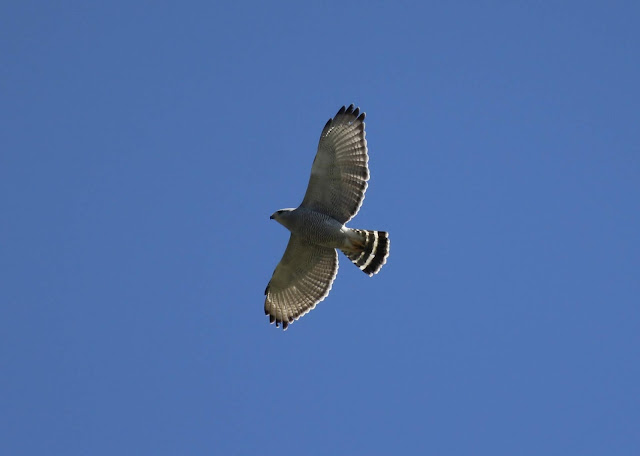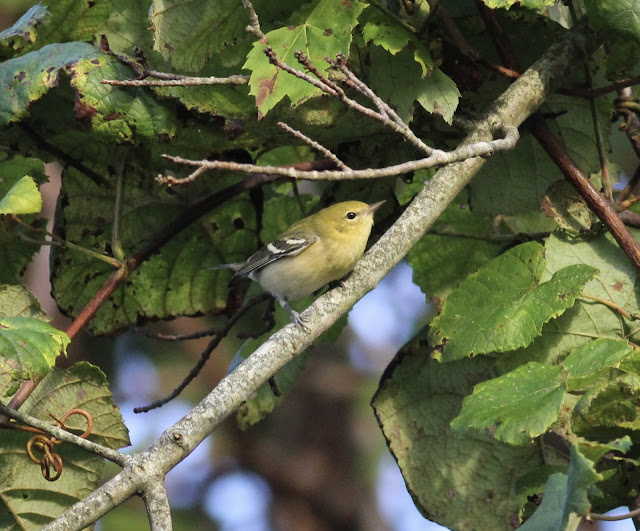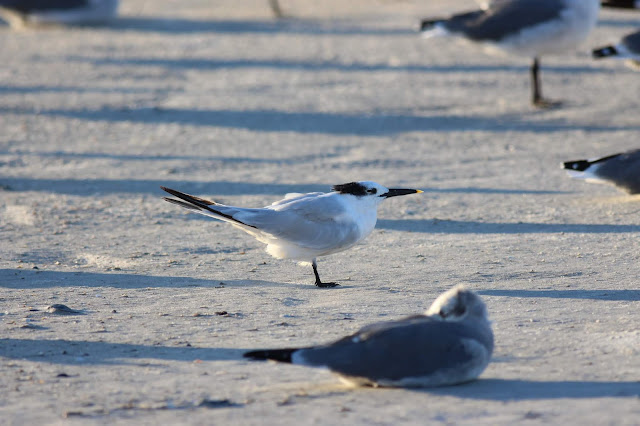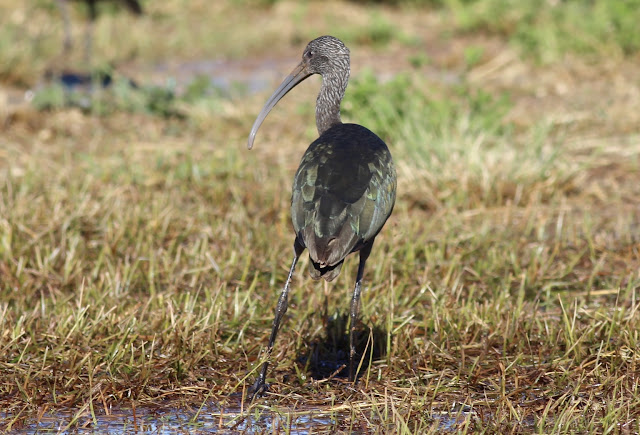Sunday, March 24, 2019
Summer Tanager (Piranga rubra) - 26Nov2016 and 13May2017
A couple more weeks and I will be reveling in the sounds of Summer Tanagers at my favorite springtime birding spot at Howell Woods. Here is one from Costa Rica at La Cinchona.
Here is one from Wilmington, NC.
Here is one from Wilmington, NC.
Gray Hawk (Buteo plagiatus) - 23Oct2017
The Gray Hawk is a really classy hawk. The color scheme and patterning is just perfect. I have seen these in Costa Rica, but these great looks were from the Lower Rio Grande Valley in TX.
Green Kingfisher (Chloroceryle americana) - 24Oct2017 & 29Jul2019
I have seen these little kingfishers in Costa Rica before, but it was nice to get a ABA area tick. This one was photographed in the lower Rio Grande Valley in TX.
This one was seen just west of Santa Marta in Colombia.
Black-striped Sparrow (Arremonops conirostris) - 24Nov2016
It's beautiful how a short glance at a fairly common bird in unfamiliar environs can be a thrilling experience. In hindsight this sighting was fairly unremarkable, but I still remember the moment years later. Actually I think I generally get more out of these birds because I find them myself and don't typically use guides. I do support locals and generally try and find opportunities to spread the wealth, but there is just something more rewarding for me in finding my own birds. Taken at Arenal Observatory Lodge.
Scarlet-thighed Dacnis (Dacnis venusta) - 24Nov2016
Per the Cornell website: "The adult male Scarlet-thighed Dacnis is unmistakable with a bright, turquoise-blue crown and nape, sides of head and neck, center of back, rump and scapulars. Its forehead, lores, sides of back, wings and tail, and mid-throat and belly are black; this is the only Dacnis that is black below. The thighs, for which this species gets its common name, are scarlet, but these are usually hidden."
True to the description, the scarlet thighs were hidden in the short glimpse I had at Arenal Observatory Lodge.
True to the description, the scarlet thighs were hidden in the short glimpse I had at Arenal Observatory Lodge.
Saturday, March 23, 2019
Great Kiskadee (Pitangus sulphuratus) - 23Oct2017
I was waiting for one of these to show up in NC since they have had one in SC for the past few years, but I could wait no more. This one is from the lower Rio Grande Valley in TX, but I have seen them in Costa Rica too.
Fiery-throated Hummingbird (Panterpe insignis) - 22Nov2016
This little gem will have to be crushed better later. Until then, here are some pics from Poas Volcano in Costa Rica.
Fox Sparrow (Passerella iliaca) - 16Nov2016 and 10Dec2018
Per the Cornell website: "Typically seen sending up a spray of leaf litter as they kick around in search of food, Fox Sparrows are dark, splotchy sparrows of dense thickets. Named for the rich red hues that many Fox Sparrows wear, this species is nevertheless one of our most variable birds, with four main groups that can range from foxy red to gray to dark brown. Since they breed primarily in remote areas, many people see them in winter when the birds move into backyard thickets."
Here is a pic from the Arboretum in Chapel Hill.
And here is one from my front yard in Wilmington!
Here is a pic from the Arboretum in Chapel Hill.
Friday, March 22, 2019
Northern Shoveler (Spatula clypeata) - 22Nov2017 & 19Jan2019
A cool fact from the Cornell Website: "The bill of the Northern Shoveler is big (about 2.5 inches long) and shaped like a shovel, but that odd-shaped bill also has about 110 fine projections (called lamellae) along the edges that act like a colander, filtering out tiny crustaceans, seeds, and aquatic invertebrates from the water."
Here is one from New York near my parent's house:
This pair was photographed at Alligator National Wildlife Refuge, NC in 2019.
Here is one from New York near my parent's house:
This pair was photographed at Alligator National Wildlife Refuge, NC in 2019.
Song Sparrow (Melospiza melodia) - 23Oct2016
The poor common species never get good coverage. Song Sparrows can be found all over the US. They are actually very diverse and can appear differently in different regions. Someday I will get around to posting pics showing the variation. For now the below photo is from Fort Fisher, NC. Here is some text from the Cornell website:
"A rich, russet-and-gray bird with bold streaks down its white chest, the Song Sparrow is one of the most familiar North American sparrows. Don’t let the bewildering variety of regional differences this bird shows across North America deter you: it’s one of the first species you should suspect if you see a streaky sparrow in an open, shrubby, or wet area. If it perches on a low shrub, leans back, and sings a stuttering, clattering song, so much the better."
"A rich, russet-and-gray bird with bold streaks down its white chest, the Song Sparrow is one of the most familiar North American sparrows. Don’t let the bewildering variety of regional differences this bird shows across North America deter you: it’s one of the first species you should suspect if you see a streaky sparrow in an open, shrubby, or wet area. If it perches on a low shrub, leans back, and sings a stuttering, clattering song, so much the better."
Field Sparrow (Spizella pusilla) - 11Nov2017
From the Cornell website: "Field Sparrows seek out open habitat with low perches, such as abandoned agricultural fields and pastures, fencerows, road and forest edges, and openings in wooded areas. You may also spot them occasionally in Christmas tree farms, orchards, and nurseries. They’ll breed in fields that were recently burned or cultivated as long as there are some trees or other perches available, but will abandon such settings as thickets of trees grow back. Shy around human habitation, Field Sparrows avoid breeding near where people live. In winter, look for them in settings similar to their summer habitats: abandoned fields and pastures, forest edges, and fencerows. In migration they’ll occasionally turn up in suburban yards."
This one was photographed at Prairie Ridge Ecostation in Raleigh, NC.
This one was photographed at Prairie Ridge Ecostation in Raleigh, NC.
Thursday, March 21, 2019
Sora (Porzana carolina) - 09Oct2016
I am still working on an unobstructed shot of this species. This particular one flushed from a high tide marsh into a tree. First time I have seen a rail in a tree. Fort Fisher, NC.
Western Kingbird (Tyrannus verticalis) - 03Oct2016 & 15Sep2017
This is a species of Kingbird that is prone to vagrancy. Come to think of it, all kingbirds seem to be prone to vagrancy.
Here is one from Airlie Gardens in Wilmington on 15Sep2017.
Bay-breasted Warbler (Setophaga castanea) - 14Sep2018
Per Wiki: " The bay-breasted warbler is a New World warbler. It breeds in northern North America, specifically in Canada, into the Great Lakes region, and into northern New England. This species is migratory migratory, wintering in northwest South America and southern Central America. "
I personally have not had very good luck with photographing this species although I have seen a bunch. This one was photographed at Heffner Gap on the Blue Ridge Parkway in NC.
I personally have not had very good luck with photographing this species although I have seen a bunch. This one was photographed at Heffner Gap on the Blue Ridge Parkway in NC.
Sandwich Tern (Thalasseus sandvicensis) - 15Sep2016
An interesting tidbit from the Cornell website: "The oldest recorded Sandwich tern was at least 24 years, 2 months old. It lived in North Carolina."
Not sure how old this one was. I found at the north end of Wrightsville Beach, NC.
Not sure how old this one was. I found at the north end of Wrightsville Beach, NC.
Caspian Tern (Hydroprogne caspia) - 05Sep2018
Per the Birds of North America website,
"The largest tern, the Caspian Tern is distinguished by its massive coral red bill, hoarse vocalizations, and similarities to large Larus gulls in flight. Bent described it as “king of all the terns . . . the dominant ruling spirit in the colonies . . . the largest, strongest and fiercest of the terns.” Its broad, expansive wings allow it to soar and wheel dramatically like a gull, and its slow wing beats power a graceful flight that is strong and swift. Its loud raucous call is heard frequently in breeding colonies, especially when nesting birds are approached by intruders.
With the exception of Antarctica, the Caspian Tern occurs on all continents, breeding and/or wintering along coastlines and inland along rivers, lakes, and marshes."
This one was photographed at the Fort Fisher Spit.
"The largest tern, the Caspian Tern is distinguished by its massive coral red bill, hoarse vocalizations, and similarities to large Larus gulls in flight. Bent described it as “king of all the terns . . . the dominant ruling spirit in the colonies . . . the largest, strongest and fiercest of the terns.” Its broad, expansive wings allow it to soar and wheel dramatically like a gull, and its slow wing beats power a graceful flight that is strong and swift. Its loud raucous call is heard frequently in breeding colonies, especially when nesting birds are approached by intruders.
With the exception of Antarctica, the Caspian Tern occurs on all continents, breeding and/or wintering along coastlines and inland along rivers, lakes, and marshes."
This one was photographed at the Fort Fisher Spit.
Wednesday, March 20, 2019
Virginia Rail (Rallus limicola) - 03Jun2016 and 02Feb2018
These furtive rails are usually heard and not seen. However, sometimes they will pop out and say hello and if they do, you better be ready. The below photo is from Bodie Island on the OBX of NC.
And here are some photos from Cedar Island in Carteret County NC.
And here are some photos from Cedar Island in Carteret County NC.
Sunday, March 17, 2019
Saturday, March 16, 2019
White-faced Ibis (Plegadis chihi) - 30Nov2015
I am not sure what happened to my old photos of a White-faced Ibis in NC. This one is from a random farm field near Phoenix, AZ.
Harris's Hawk (Accipitridae) - 24Oct2017
Per one of the Cornell websites: "A handsome hawk of the arid Southwest, Harris's Hawk is a standout with bold markings of dark brown, chestnut red, and white; long yellow legs; and yellow markings on its face. The most social of North American raptors, these birds cooperate at nests and hunt together as a team. When hunting, a group of hawks surround their prey, flush it for another to catch, or take turns chasing it. This hawk's social nature and relative ease with humans has made it popular among falconers and in education programs."
The below pics are from my Lower Rio Grande trip with my brothers.
The below pics are from my Lower Rio Grande trip with my brothers.
Vermilion Flycatcher (Pyrocephalus rubinus) - 24Oct2017 & 11Dec2020
Can you imagine a more eye catching bird? This striking male was seen on my trip to the lower Rio Grande Valley with my brothers.
Here is a Vermilion Flycatcher from NC at a farm in Martin County. Thanks Bob for welcoming the twitchers to your farm!
Northern Flicker (Picidae) - 25Nov2015 & 25Jan2018
Flickers seem to be one of those species that do not like to be photographed. Here is one of the "red-shafted" sub-species out west. This one was photographed in Madera Canyon, AZ.
Here is our "golden shafted" eastern variant photographed in NC.
Subscribe to:
Posts (Atom)



